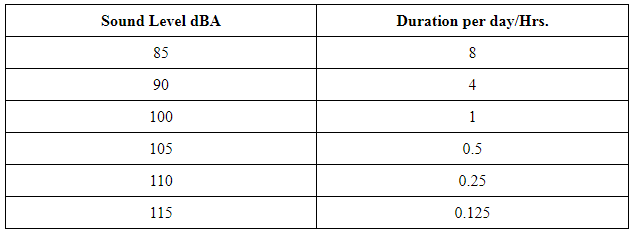Noise calculation and management at workplace to ensure Health and safety
The noise can be measured with the help of an instrument called sound meter or noise meter. These meters provide instant sound pressure level (SPL) and the best way to utilize noise meter devices is to take multiple readings at different points of the inspecting area to get their mean. It is also important to share that we can measure the Noise level with smartphones by installing appropriate noise level checker applications (it gives us an idea of Noise level) – but it is not an alternative of the sound meter or Noise meter due to its sensitivity and calibration factors.
The noise/sound level dBA and human exposure with respect to time is inversely proportional as the sound level increases the permissible exposure time decreases. Below table shows the decrease in exposure time limits with respect to sound level dBA;
When the noise level at any workplace exceeds the below-tabulated noise level employer should take control measures to safeguard the workers from noise exposure. This can be done in various ways and discussed in this article later.
When the daily noise exposure is consists of two or more times of different noise levels, their resultant
effect should be accounted, for rather than the individual effect. Different levels of exposure to for various
periods of time shall be calculated according to the formula.
F(e)=(T1/L1)+(T2/L2)+(T3/L3)+ ------- +(Tn/Ln)
F(e) = The equivalent noise exposure factor.T1 = The first period of noise exposure at any essentially constant level
L1 = The duration of the permissible noise exposure at the constant level during the first period of noise
T2 = The second period of noise exposure at any essentially constant level
L2 = The duration of the permissible noise exposure at the constant level during the second period of noise
Tn = The last period of noise exposure at any essentially constant level
Ln = The duration of the permissible noise exposure at the constant level during the last period of noise
If the ratio of time and noise exposure is equivalent to unity the level of noise for during that specific time is at acceptable/permissible level...
Let's elaborate the above ratio with an example;
A supervisor on a construction site is assigned to observe the three different operations
that include 1) Power Generator room Operation for 1 Hr. 2) Welding Operation for 0.5 Hr.
3) Crane Operation for 2 Hrs. The noise level on each site is given in the table below - calculate the noise exposure factor (Fe) for the Supervisor to ensure his safety.
Calculation
Fe=(T1/L1)+(T2/L2)+(T3/L3)+ ------- +(Tn/Ln)
Fe=(1/85)+((½)/80)+(2/105)
Fe=0.3706 = 0.4
Hence the Fe is less than unity the noise level
is in permissible limit
is in permissible limit
How to Control Noise
The noise hazard can be control three ways- Noise Control at the source
- Noise control between source and receiver (human)
- Noise control at receiver level (human)
Noise Control at the source
This can be done either by employing noise-proof machine or jacketing/provision of the soundproof coat to the machine or equipment
The noise can be reduced by substituting the machine/tool or equipment which produces low noise without affecting efficiency or work output.
The noise level can be lower by maintenance of the machinery especially by using lubricant on the
mechanical parts of the machine.
Silencing can be also used to reduce the noise at source level - especially in vehicles and diesel power generators where a silencer can be fitted on the exhaust to suppress the noise.
Lastly, the noise can be reduced at source by damping method (especially in metal surfaces)
Noise control between source and receiver (human)
The noise between source and listener can be reduced by multiple ways including insulation, isolation, and absorption.
Noise control at receiver level (human)
The noise can be controlled at the listener level by the provision of personal protective equipment such as earplugs or earmuffs. Secondly, noise can also be controlled at the receiver end by the provision of acoustic heavens.
Effects of exposure to noise
There are many effects of being exposed to noise at work and these effects are classified into two categories including physical effects and psychological effects.Physical effects are;
- Temporary loss of hearing ability
- Temporary ringing in ears
- Tinnitus
- Lower the hearing ability









This post is extremely radiant. I extremely like this post. It is outstanding among other posts that I’ve read in quite a while. Much obliged for this better than the average post. I truly value it! acoustic control in buildings
ReplyDeleteIt provides comprehensive knowledge of the subject. Everything written in this blog is close to satisfactory level. I am sure no one can raise any issue about all the information delivered here.
ReplyDeleteacoustic insulation gold coast
This can be done either by employing noise-proof machine or jacketing/provision of the soundproof coat to the machine or equipment
ReplyDeletehttps://www.aimvisionsafety.co.in/